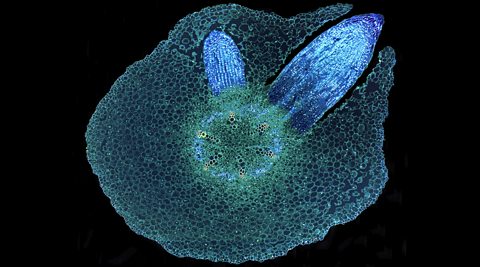Plant tissues
meristemA region in plant shoots and roots in which cells are dividing, and so are undergoing mitosis. are found at the tips of roots and shoots. Here, unspecialised stem cells undergo a type of cell division called mitosisA type of cell division which produces daughter cells identical to the parent.. This does not occur in other parts of the plants. In all other parts of plants, cells can only become bigger in a process called cell elongation.
Cells produced by mitosis in meristems help plants continue to grow in height and width throughout their life. Animals do not have meristems, so they stop growing in size once they become adults.
Plant meristems divide to produce cells that increase the height of plants, the length of roots and the girth of the stem. They also produce cells that develop into leaves and flowers. So they can differentiate into specialisedA cell that has become differentiated to carry out a particular function, eg red blood cell. cell types depending on where they are in the plant.

Plant structures
As multicellular plants, like multicellular animals, increase in size, their smaller surface to volume ratio becomes smaller. Because of this, they have evolved tissues, organs and organ systems. As in animals, these are specialised.
Together, the roots, stem and leaves form a plant organ system for transporting and exchanging substances around the plant.
Plants take in water from the soil, along with dissolved ions such as nitrate - which they use to make proteins - and magnesium - which they use to make chlorophyllThe green chemical inside the chloroplasts of plant cells. It enables photosynthesis to take place.. These are transported in the roots, stem and leaves.
Any part of a plant above ground, where it is exposed to light, can photosynthesise. But a plant's leaves are the main organ of photosynthesisA chemical process used by plants to make glucose and oxygen from carbon dioxide and water, using light energy. Oxygen is produced as a by-product of photosynthesis. Algae subsumed within plants and some bacteria are also photosynthetic..
Plant leaves are adapted for gas exchange and photosynthesis.
| Feature | Function |
| Large surface area | For maximum absorption of light; for optimum absorption of carbon dioxide |
| A thin, flattened blade - though there are exceptions | So that water and gases have a limited distance to diffuse |
| Vascular tissue in the midrib and veins | Branches of the xylem, to transport water and minerals to the leaf; branches of the phloem, to transport glucose and other products of photosynthesis to other parts of the plant |
| Air spaces between cells within the leaf | For the diffusion of gases |
| Feature | Large surface area |
|---|---|
| Function | For maximum absorption of light; for optimum absorption of carbon dioxide |
| Feature | A thin, flattened blade - though there are exceptions |
|---|---|
| Function | So that water and gases have a limited distance to diffuse |
| Feature | Vascular tissue in the midrib and veins |
|---|---|
| Function | Branches of the xylem, to transport water and minerals to the leaf; branches of the phloem, to transport glucose and other products of photosynthesis to other parts of the plant |
| Feature | Air spaces between cells within the leaf |
|---|---|
| Function | For the diffusion of gases |
The structure of a leaf
Plant leaves are adapted for photosynthesis, and the exchange of gases required for the process. The structure of the tissues is related to their functions in the plant.
Absorbing light energy
The palisade mesophyllPlant tissue containing closely packed cells in the upper layer of a leaf. layer of the leaf is adapted to absorb light efficiently. The cells:
- are packed with many chloroplastContains the green pigment chlorophyll; the site of photosynthesis.
- are column-shaped and arranged closely together
- towards the upper surface of the leaf
Gas exchange
spongy mesophyllThe plant tissue in a leaf which has loosely packed cells and air spaces between them to allow gas exchange. tissue is packed loosely for efficient gas exchange. The spongy mesophyll cells are covered by a thin layer of water. Gases dissolve in this water as they move into and out of the cells.
When the plant is photosynthesising during the day, these features allow carbon dioxide to diffuse into the spongy mesophyll cells, and oxygen to diffuse out of them.
To enter the leaf, gases diffuse through small pores called stomataTiny holes in the epidermis (skin) of a leaf. They control gas exchange by opening and closing and are involved in loss of water from leaves. Singular is stoma.. As the stomata open, water is lost by the process of transpirationThe loss of water from leaves by evaporation through the stomata.. Closing the stomata helps to control water.